5G is the fifth generation of mobile, cellular technologies, networks and solutions. It promises a major change in mobility, is seen as a major driver for next-generation (industrial) digital transformation in numerous countries, and, although not just ‘built’ for IoT, it is heralded as a major driver of the growth of the Internet of Things, Industrial IoT and Industry 4.0.
It’s mainly in the scope of IoT trends that we tackle 5G in this overview with a brief explainer and forecasts for the usage and role of 5G in IoT and its expected impact on mobility in evolving connected business realities.
When bridging digital and physical by leveraging IoT and cyber-physical systems and when striving towards ever more automation and autonomous decisions in environments such as smart factories, autonomous vehicles, smart buildings, smart cities and connected industrial applications in IoT in manufacturing, to name a few, you do need quite some resources to deal with the resulting deluge of data that needs to be analyzed and gathered to begin with.
By 2021 5G’s broad enablement of IoT use cases will drive 70% of G2000 companies to spend $1.2 billion on connectivity management solutions (IDC)
It’s why edge computing, advanced analytics and artificial intelligence become so important in IoT and why edge computing is certainly among the top ‘IoT evolutions’.
In its Worldwide IoT Predictions 2018, announced in a November 1, 2017 webcast, IDC stated that by 2020, IT spend on IoT edge computing edge infrastructure will reach up to 18 percent of the total spend on IoT Infrastructure – and there is quite some infrastructure.
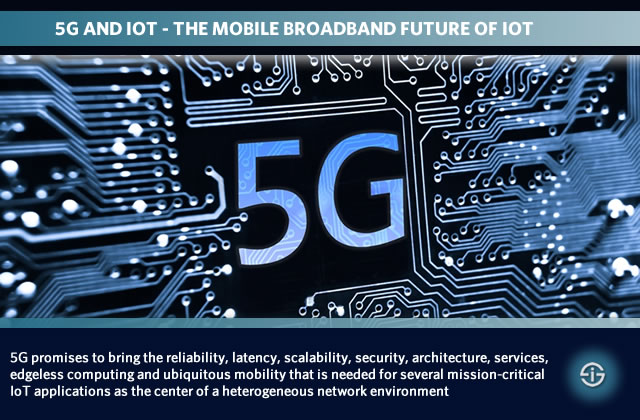
However, to enable a hyper-connected environment, leveraging IoT on a real-time and massive scale whereby there are so many variations in the context of IoT-enabled applications (some have moving parts, some have remotely located parts, some require fluctuating bandwidth, some need extreme reliability, the list goes on), ultimately many of the network technologies that we have today aren’t really fit for the future and even today we often need to use a mix of fixed and wireless network technologies to realize massive IoT projects, let alone the ultra-connectivity we are seeing in the next decade. Enter 5G.
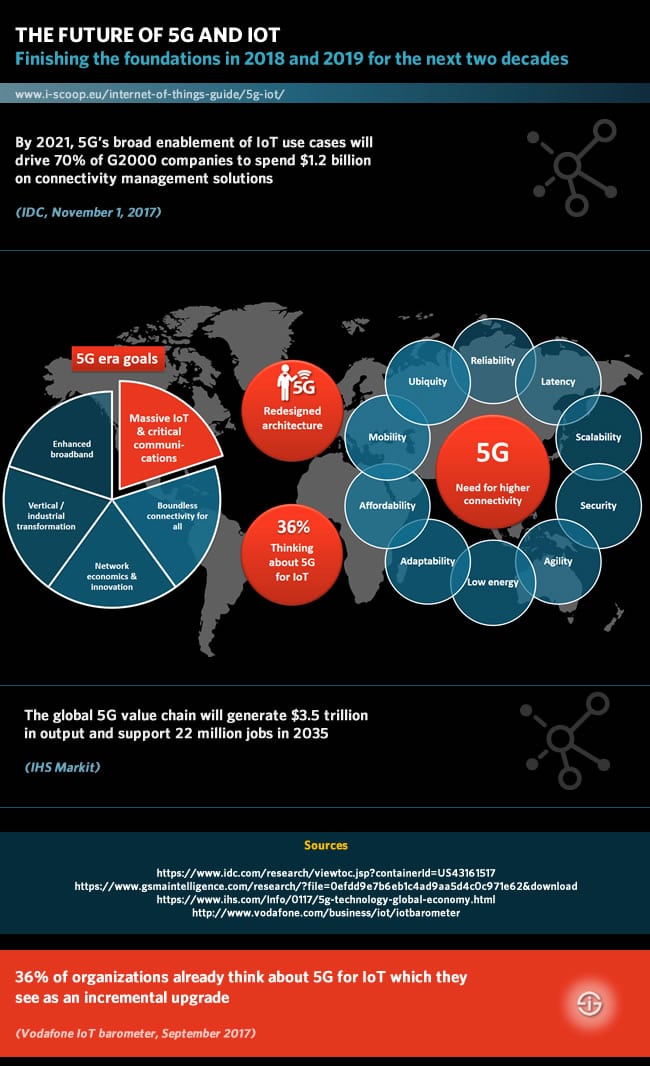
The promise of 5G and massive IoT
Many of today’s IoT projects do fine with the low data rate solutions they require to function, along with the low costs explaining the success of non-cellular LPWAN technologies in several areas and of current cellular IoT solutions.
But what with mission-critical, performant and reliable connections in mass IoT applications of tomorrow and in some of the mentioned areas such as connected vehicles (moving parts) and the industrial processes of Industry 4.0 at scale or smart cities on the next level? The reach and capabilities of several existing LPWA network technologies are increasing and the possibilities of cellular solutions such as 4G LTE continue to be pushed but 5G is on the horizon to deal with those.
5G promises to bring the reliability, latency, scalability, cybersecurity and ubiquitous mobility that would be needed for several mission-critical services in the IoT space and beyond.
Moreover, 5G promises to offer a new infrastructure and design with inherent capabilities that already offer several new services. And, last but not least, it promises to do so at a low costs, with high agility and at low energy consumption (with 5G new types of devices will come that are suited for low-power applications), making it a key component of the communications and connectivity layer of the IoT technology stack. It almost sounds too good to be true.
5G and IoT – industrial IoT and edgeless computing
While it indeed almost sounds to be good to be true the 5G race is on since a few years now in operator land and steps continue to be taken for massive deployment in the – rapidly approaching – next decade.
Thanks to a step-change in latency, 5G could be used to control robots working in unpredictable conditions (David Hutton, GSMA)
If you’re new to 5G, it’s important to know that there is no real 5G yet. Moreover, there are different visions with regards to the next generation of mobility. You also need to know that both in IoT and industrial IoT (IIoT) there is an evolution towards more wireless connectivity with LPWA(N) or low power wide area (networks) being the fastest grower in connectivity until 2021 in the Industrial IoT connections, which power the evolution of IIoT and Industry 4.0 as described in our article on IIoT communication and connectivity technology 2017.
5G is not just for industrial IoT, it stretches or will stretch much further and proponents say that it will massively change mobility as we know it today. Still, from an IoT perspective major support for the advancement of 5G happens within companies and associations that want to boost industrial transformation and the Industrial Internet or Industry 4.0.
The reasons: as enhanced mobile broadband, 5G aims to enable massive IoT, offering the network capacity and performance in myriad applications of IoT in the most diverse contexts: from those connected vehicles and other moving objects to the most bandwith-intensive applications in massive machine types of communications, remote surgery, the connection of billions and billions of IoT devices, the types of applications that need next-level experiences, the steering of robots and far more mundane applications with the benefit of one wireless network to enable it all and promising the mentioned reliability and so forth.
57% of respondents from end-user organizations believe that their organization’s main intention is to use 5G to drive Internet of Things (IoT) communication (Gartner)
As a token of the industrial support for 5G a few examples. The OpenFog Consortium, which was launched by Cisco in the context of its fog computing approach and is mainly meant for data-intensive IoT applications where intelligence (analytics) is brought to the edge, aims to enable AI, IoT and 5G with fog computing and is a proponent of 5G.
Or take the Made Smarter Review, an impressive document that was released in October 2017 and should be the foundation of the UK’s industrial transformation strategy for smart manufacturing for years to come: it also foresees the pushing of R&D in several Industrial IoT connectivity areas of which 5G is one. We can go on: also in the rest of Europe (the EU action plan on 5G in the scope of its digital single market strategy), in the US and across the globe, associations aiming to give industrial IoT a boost are involved in the nascent so-called ‘5G era’.
It is not a coincidence we mentioned the OpenFog Consortium by the way. 5G also has an edgeless computing taste as devices become part of the network instead of endpoints in the sense we know them today. In other words: closer to people and, in the scope of IIoT, closer to machines such as robots and whatnot.
The future of 5G and IoT – and the future impact of 5G beyond IoT
Will 5G be the highly adaptable, scalable, reliable and redesigned next step in cellular IoT connectivity that is suited for our ever expanding need for connectivity?
Again, we aren’t there yet at all but knowing that 5G is an extension of the LTE and all LTE-Advanced networks yet at the same time it comes with an entirely new network architecture (with consequences for operators who need to leverage software-defined networking and network functions virtualization), which offers more than just the impressive data rates it offers (more below), that it also promises to build upon the investments that organizations have already made today and that it might be ubiquitous in 10-20 years from now, far beyond IoT, chance is real.
When gauging the willingness among end-user organizations to pay more for 5G, in the Summer of 2017 Gartner found that, according to the expectations of respondents 5G would play an important role in IoT in their organizations.
Although there was some confusion among respondents as to when 5G would be widely available (a large majority believed 2020) IoT communication surprisingly turned out to be the main use case for 5G (57 percent of respondents).
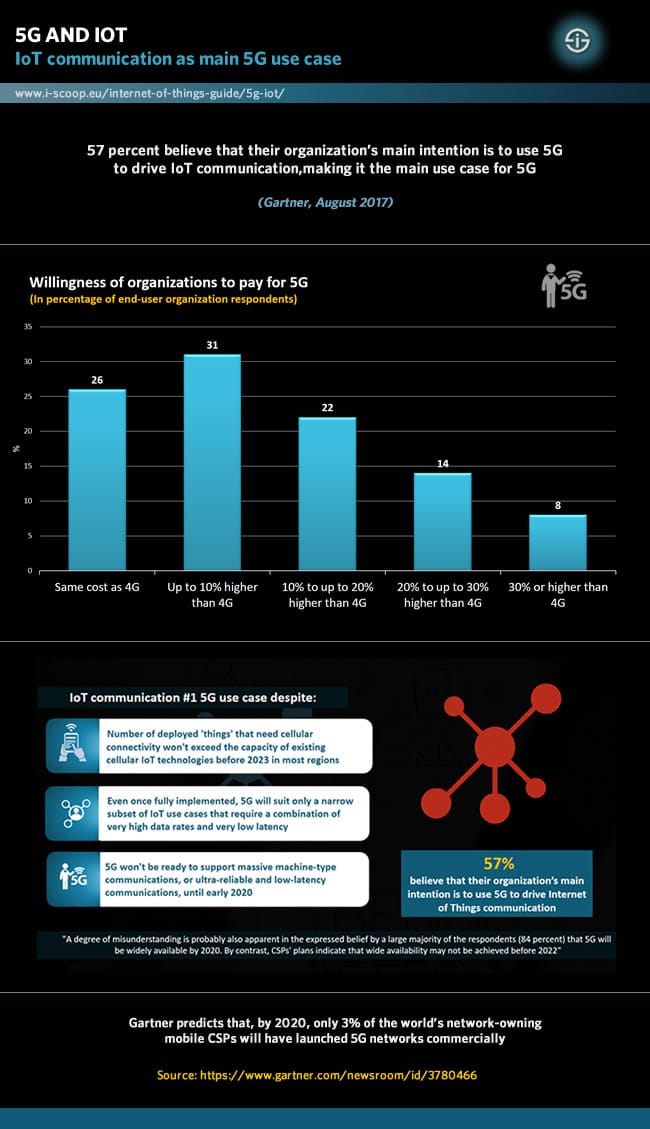
It was surprising for many reasons as depicted above: as research director Sylvain Fabre reminded, the number of connected IoT things needing cellular connectivity would not go beyond the capacities which are offered by current cellular IoT connectivity solutions in most areas across the globe before 2023.
Moreover, even when 5G is fully ready, he expects that just small portion of IoT use cases needs the high data rates and low latency as offered by 5G and, finally, he expects that it will take until 2020 before 5G can support the massive machine-type communications or highly reliable low-latency communications it promises.
At the same time the world doesn’t stop and a mix will always be needed as there is always something that needs a different approach or simply doesn’t need the capacities of 5G. The GSMA sees 5G as the center of a heterogeneous network environment with other connectivity solutions such as LPWA.
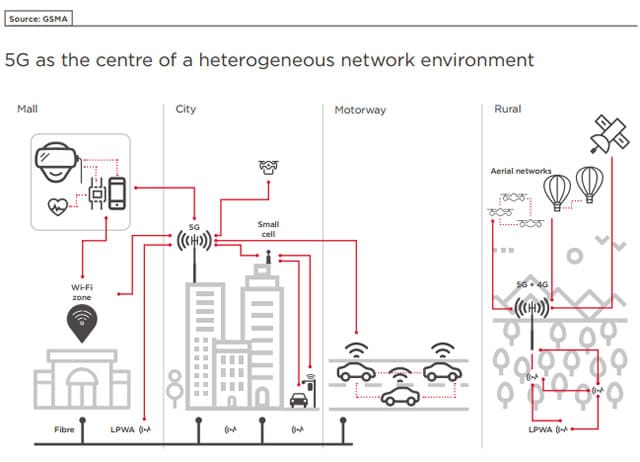
Moreover there are those voices that urge to wait or can take unforeseen measures. In September 2017 over 180 scientists, oncologists and health experts did submit a letter to the European Commission to have more time for independent research with regards to 5G radiation as they fear the health consequences of 5G.
Ubiquitous connectivity on all possible levels with high data rates does mean ubiquitous radiation and it wouldn’t come as a surprise if more time is indeed needed. After all, in the end with 5G we’re talking about connecting everything and loads and loads of data being sent in IoT and in consumer applications with video being one. Moreover, 5G also promises to work well deep inside buildings (radiation indeed).
Yet, at the same time the operators and industrial markets don’t sit still either of course. And there is more research that indicates the expected role of 5G for IoT than the Gartner survey.
According to the mentioned “IDC FutureScape: Worldwide IoT 2018 Predictions”, unveiled early November 2017 in a webcast, by 2021 5G’s broad enablement of IoT use cases will drive a whopping 70% of Global 2000 companies to spend $1.2 billion on connectivity management solutions.
36% of organizations already think about 5G for IoT which they see as an incremental upgrade (Vodafone IoT barometer)
It’s one of the ten predictions in the company’s forecasts for IoT in 2018 and beyond. Despite the concerns and although there is no real 5G yet and the final full specifications of 5G are expected for somewhere end 2019 and in 2018 and 2019 we’ll mainly see 5G being showcased and tested/deployed on limited scales, 5G is expected to drive IoT’s further and accelerating deployment. One could indeed say, in IoT and beyond, that 5G is a burning hot topic. It has been for several years but it’s even more now and 5G can be added to your list of IoT 2018, 2019, 2020 and so on trend lists.
What do the operators who are in the 5G race think about 5G and IoT themselves, or better what do their surveys say? According to the Vodafone IoT barometer, which was announced on September 27th, 2017, 36 percent of responding organizations would already be thinking about 5G for IoT which they see as an incremental upgrade.
As said, 5G is not just about IoT and on the longer term the 5G era and the way it is expected to transform industries and the very nature of mobility as we know it leads to even more impressive forecasts.
According to IHS Markit, for instance, in 2035, 5G will enable $12.3 trillion of global economic output (which is more or less the same total amount of consumer spending in 2016 in the US), the global 5G value chain will generate $3.5 trillion in output and support 22 million jobs in 2035 (which is a higher output than that of the full mobile value chain today) and from 2020 t0 2035, the total contribution of 5G to real global GDP will be equivalent to an economy the size of India. That’s indeed a lot.
5G in the spectrum of existing wireless IoT network solutions
Back to 5G and wireless IoT connectivity. So, 5G is a cellular (like 2G, 3G, 4G, LTE-Cat M and NB-IoT) wireless wide area network standard (see our wireless IoT protocols and network technologies article for all those names).
You know what 2G, 3G and 4G are. CAT-NB1/NB-IoT is focused on very low data rates and can use the 2G, 3G and 4G spectrum, making it a so-called LPWA technology. Then there is LTE Cat-M1, just like NB-IoT designed for IoT, which is also classified under the cellular LPWA umbrella and offers the highest bandwidth of cellular LPWA technology. On top of cellular LPWA you have non-cellular LPWA networks such as LoRa(WAN), Sigfox and more.
LPWAN, including NB-IoT (Narrowband IoT) and LTE-M (Long Term Evolution for Machines), both standardized within the 3GPP (that also standardized 2G, 3G, 4G and will standardize 5G) is going mainstream in IoT land. That was not just one of our IoT predictions for 2017 but remains a prediction for IoT in 2018.
This is also the case in Industrial IoT where LPWA as said is the fastest grower, certainly in new IIoT connections (even if the majority remains fixed line).
So, what about 5G? The first phaze of the finalization of 5G specifications by that same 3GPP is expected in 2018 and, as said, full specifications are expected by end 2019 as you can read in this article by David Hutton, Director of Technology at the GSMA.
The global 5G value chain will generate $3.5 trillion in output and support 22 million jobs in 2035 (IHS Markit)
5G is expected to reach network speeds up to 20 Gbps (gigabits per second) or more. On October 17, 2017 Qualcomm announced that it had achieved a 5G data connection on a 5G modem chipset for mobile devices, achieving gigabit download speeds. By way of comparison: LTE Cat-M1, specifically developed to connect IoT devices to a 4G network goes up to 10 Mbps while NB-IoT or Narrowband-Internet of Things sits in the range below 350 Kbps. You see the difference.
5G isn’t just able to transport more data at much faster data transfer rates than 4G LTE as the numbers above show, it also will support a huge number of devices at the same time in a specific range with a connection density that is about 500 times as high as is the case with 4G.
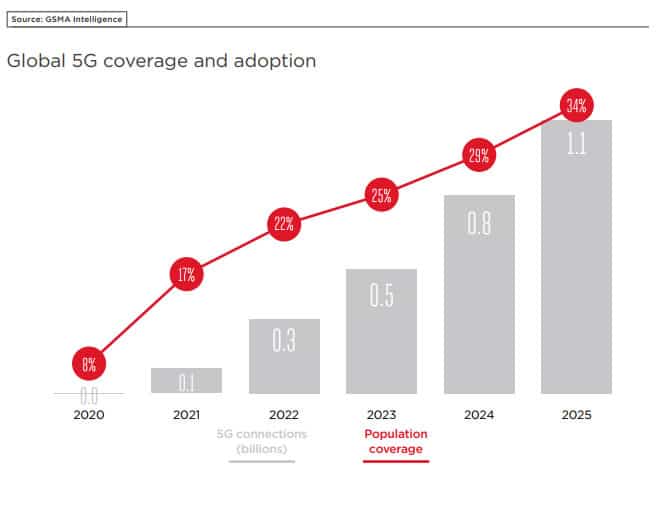
Again, today of course far from all IoT use cases need 5G or NB-IoT for that matter. In most industrial IoT cases you’ll also find a mix of, on average, four connectivity solutions. One of the reasons why 5G is so hot in general is the push of operators. And one of the reasons why it’s important in the next years in IoT has to do with the fact that there are ever more data-intensive and complex IoT deployments where ubiquitous fast mobile connectivity becomes important.
This is certainly not all that can be said about 5G, nor about 5G and IoT but do remember that as the 5G race among the operators keeps raging as it has been for some years now, 2018 and 2019 will see important evolutions in 5G, making it ready for IoT usage at larger scale by 2020-2021.
Top image: Shutterstock – Copyright: wk1003mike – All other images belong to their mentioned owners

